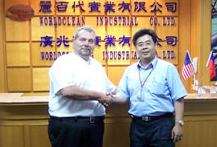
-----
How is it possible to re-hard coat anodize without stripping?
2003
I have been a shop manager for over 25 years and have been sending out machined parts for Hard anodizing at least that long. Most of what we build functions in the sea. We are a professional R&D shop and we specialize in acoustics. Many of the parts and units we manufacture are expensive and one of a kind. We try to use parts over if possible. My question is once a part is hard coat anodized type III class I with a 5% dichromate seal per MIL-A-8625 / MIL-PRF-8625 [⇦ this spec on DLA]f, what can be done as far as re-anodizing without stripping? Most parts can't be stripped because to much aluminium stock is removed and pitting occures which destroys the necessary finish required for sealing and the parts end up undersize which makes them to far out of tolerance. We have polished out some areas of parts to be re-anodized and over the top of most of the present anodized. Most of the time it doesn't work very well. Discoloration occurs but this is not critical to the function of the parts in most cases.
Please advise.
Robert L. ProngMachine Shop Manager - Seattle, Washington, USA
Hello Robert,
Normally an anodized part cannot be re-anodized without stripping. The primary reason for this is that anodize is non-conductive, and to build anodic coating you will need good contact with the bare metal. Now this being said, if the original racking was bolted to threads on your parts, those same threads could be potentially used again and an anodic coating possibly could be made without stripping. I would only attempt this in a last ditch effort to prevent scrapping materials, but that could be the case just the same as the current used to build on your bare surfaces could burn the remaining anodic coating. Most reputable platers will not perform this as the risk is high that the parts would suffer in process...but it can be done.
Bill GraysonMetal Finishing - Santa Cruz, California
2003
2003
Robert,
Unfortunately the process itself is the problem. The oxide is built by using the base metal to form the thickness. Generally 50% of the oxide thickness is needed from the underlying aluminum to create the oxide , therefore when the oxide is stripped you have less aluminum left.I do not know of any way around this, you are limited to strip, polish and re-anodize to dimension.

Drew Nosti, CEF
Anodize USA
Ladson, South Carolina

Q, A, or Comment on THIS thread -or- Start a NEW Thread